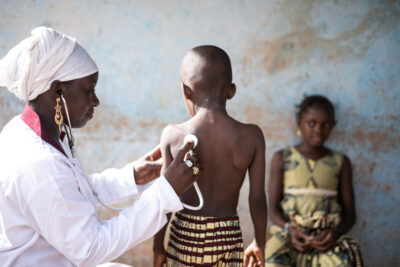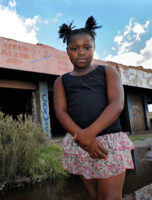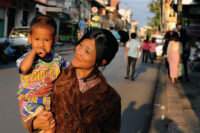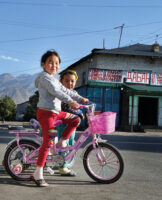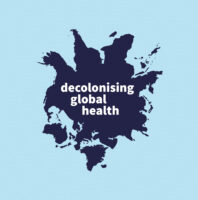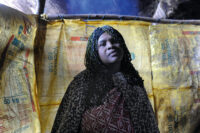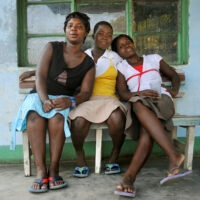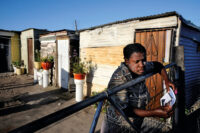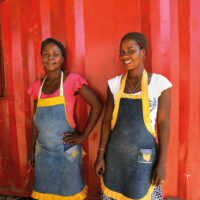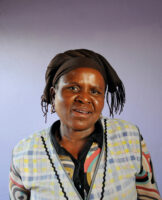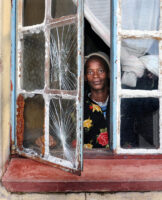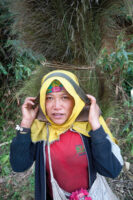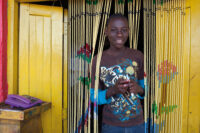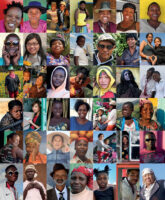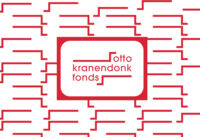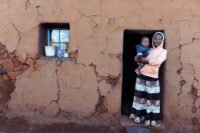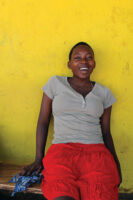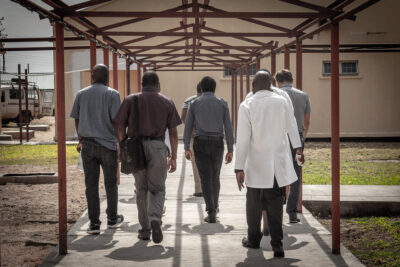Main content
Investments in the health work-force are central to achievement of health-related sustainable devel-opment goal (SDG) targets.(1,2) Ethiopia faces multiple challenges with its health workforce. These include shortages of man-power, poor quality of education and training, and uneven distribu-tion and retention of health workers. The country has made notable efforts to address these challenges, including doubling the health work-force in the public sector in the past five years.(3)
Evidence is critical for informing Ethiopia’s policy makers about the effectiveness of the policies and programmes that are implemented to facilitate achievement of its Human Resources for Health (HRH) targets (4,5). Through the USAID funded Strengthening HRH Proj-ect, Jhpiego and its partners have been supporting the government of Ethiopia to improve HRH manage-ment, to increase the production and quality of training of health workers, and to generate evidence. Three PhD candidates enrolled at the VU University in Amsterdam used data generated by the HRH Project to develop their theses. Below are excerpts from their thesis papers, addressing the quality of pre-service education, health worker task analysis and retention of health workers, respectively.

I. Quality of preservice education for healthworkers (6,7)
Methods
The HRH Project conducted a national study to assess the quality of education in public midwifery and anaesthesia schools in June and July 2013. All public Ethiopian institu-tions with anaesthesia and/or midwifery pre-service education programmes were eligible for the study. The study recruited 484 midwifery and 122 anaesthesia students who had com-pleted their final year and were just about to graduate, and covered 25 out of 30 eligible midwifery schools and 6 out of 10 anaesthesia schools. Student competence was assessed using objective structured clinical examination (OSCE) and data on educational resources and quality of the teaching/learn-ing environment collected through structured interviews.

Results
Midwifery students scored 51.8% overall, while anaesthesia students scored 61.5% in the competence assessments on the respective sets of skills that were assessed, as shown in Figure 1. Midwifery scores ranged from 32.2% for manual vacuum aspiration to 69.4% for active management of third stage of labour. Anaesthesia scores varied from 36.7% for routine anaesthesia machine check to 79.5% for spinal anaesthesia.
Less than half of the midwifery students reported adequate numbers of classroom instructors (43%), skill laboratory assistants (28.9%), and clinical preceptors (21.5%). The cor-responding percentages for anaesthesia students were 38.5%, 4.9% and 35.6%, respectively. Only 56.2%, 44.6% and 19.2% of midwifery students thought their instructors were effective in facilitating learning in classrooms, skills laboratories and clinical sites, respectively. Among anaesthesia students, the corresponding figures were 50%, 9% and 47.1%. Classroom resources were deemed to be available and helpful by 43.8% of midwifery and 26.2% of anaesthesia students, while skills laboratory resources were said to be available and helpful by 28.3% of mid-wifery and 9% of anaesthe-sia students. About half of each student group felt they received sufficient practical experience: 49.6% of mid-wifery students and 55.7% of anaesthesia students. The study also found that only 32% of midwifery and 57.4% of anaesthesia stu-dents met the curriculum requirements of having con-ducted at least 20 deliveries and 200 intubations before graduation, respectively.
Implications
Our findings suggest weaknesses in the quality of pre-service education, given the poor performance of students in certain es-sential skills, and based on the reported lack of adequate resources at the training institutions. This has important implications for education institutions and regulatory bodies, which have a responsibil-ity to ensure that their programmes meet the stan-dards for quality teaching and learning. It is also a concern for the health sector where safety and quality of care are high priorities.
II. Health worker task analysis (8,9,10)
Methods
The HRH Project conducted a task analysis study to assess gaps in the education and practice of midwives, anaesthe-tists and health extension workers (HEWs). Draft task lists were developed from relevant documents and validated by experts. The final lists consisted of 86 midwifery, 74 anaes-thesia and 62 HEW tasks. Data were collected in December 2013 from health workers with six months to four years of professional experience. A total of 138 midwives, 137 anaes-thetists, and 82 HEWs participated in the study. We mea-sured four indicators: frequency of performance, criticality of the task, competence, and timing/location of training.
Results
We selected five tasks from each cadre that are directly relevant to maternal health (Table 1). The large major-ity of midwives considered themselves competent in providing all the selected tasks, including family plan-ning services and basic emergency obstetric and newborn care (BEMONC). They indicated that they performed these tasks frequently (daily or at least once a week).
Most felt that these tasks were highly critical for patient outcomes (69-75%), except for family planning (47.8%). Around two-thirds of the respondents said they had learned the tasks during pre-service education, except for BEMONC (47.1%). Generally, family planning received lower scores for frequency, criticality, competence and training during pre-service education compared to the other four tasks.
Almost all anaesthetists rated themselves as being compe-tent in pre-anaesthetic evaluation, selecting and administer-ing anaesthetics, patient monitoring during anaesthesia, basic life support, and management of anaesthesia-related complications (92% or more). Nine out of 10 stated that they performed all the tasks frequently (daily or weekly), except for basic life support (38.6%) and management of anaesthesia related complications (64.2%). The majority (82-88%) also felt that these tasks were highly critical, and said they had learned them during pre-service education.
Almost all HEWs considered themselves competent in providing family planning services. More than half of them indicated they performed these tasks frequently. Except for family planning (46.3%), most of the HEWs said the tasks were highly critical. The tasks that were cited most as top-ics covered during pre-service education were family plan-ning and post-natal care. Clean and safe delivery received generally lower ratings across all the four variables.
Implications
All three cadres feel confident in their ability to perform the tasks assigned to them. Additional emphasis is recom-mended for tasks performed less frequently and those that are cited less as topics covered during pre-service education.
III. Retention of health workers (11)
Methods
The study employed a two-stage cluster sampling design to assess nurses’ intention to leave their jobs and its deter-minants. Four hundred and twenty four nurses were ran-domly sampled from 125 public health facilities. Data were collected in June 2014 using interviews. Percentages and composite mean scores (ranging from 1 to 5) were computed and multivariable logistic regression analysis was done.
Results
Half of the nurses (50.2%) intended to leave their job in the next year. The multivariable regression model showed that three variables were significantly associated with intention to leave. Nurses who had a university degree were more likely to intend to leave their jobs in the next year compared to nurses who had a diploma (adjusted odds ratio (AOR)=2.246; 95% CI=1.212- 4.163; p<0.01). Nurses with limited opportunities for professional development were more likely to intend to leave their current jobs (AOR=1.398; 95% CI=1.056-1.850; p<0.02). Intention to leave declined by 5% for each year of work experi-ence (AOR=0.948; 95% CI=0.914- 0.982; p<0.01; Table 2).
Implications
The high rate of intention to leave the job suggests a need for improved retention mechanisms for junior nurses and bachelor degree holders, and better oppor-tunities for on-the-job professional development.
Overall conclusion
Evidence from the assessment of graduating students and task analysis suggests that strengthening the health work-force in Ethiopia will require additional efforts to improve the quality of pre-service education. Task analysis results suggest that additional efforts should be made to strengthen HEWs’ pre-service education on all the tasks presented in this paper, as well as family planning and BEMONC for midwives. The alarmingly high rate of nurses who in-tend to leave their jobs also requires serious attention.
| TASK | % of health workers who reported that: | |||
|---|---|---|---|---|
| They were proficient or competent in performing the task | They were trained during pre-service education to perform the task | The task was highly critical to patient outcomes | They routinely (daily or weekly) performed the task | |
| Midwifery (n = 138) | ||||
| Family planning counselling and services | 89.1 | 54.3 | 47.8 | 65.2 |
| Antenatal care | 96.4 | 73.2 | 72.5 | 77.5 |
| Clean and safe delivery | 98.8 | 69.6 | 73.2 | 91.3 |
| BEmONC | 94.2 | 47.1 | 75.4 | 72.4 |
| Postnatal care | 99.3 | 68.1 | 68.8 | 92.0 |
| Anaesthesia (n = 137) | ||||
| Pre-anaesthetic evaluation | 98.5 | 87.6 | 83.9 | 89.1 |
| Select and administer anaesthetics | 92.0 | 86.9 | 86.1 | 94.9 |
| Patient monitoring under anaesthesia | 98.6 | 83.2 | 81.8 | 90.5 |
| Basic life support | 96.3 | 85.4 | 88.3 | 38.6 |
| Manage anaesthesia related complications | 100 | 83.2 | 83.2 | 64.2 |
| Health Extension workers (n = 82) | ||||
| Family planning services | 98.8 | 56.1 | 46.3 | 75.6 |
| Focused antenatal care | 98.8 | 48.8 | 64.6 | 61.0 |
| Clean and safe delivery | 78.0 | 35.4 | 58.5 | 51.2 |
| Essential newborn care | 96.3 | 50.0 | 58.5 | 73.2 |
| Post-natal care | 100 | 57.3 | 62.2 | 85.3 |
| Predictors | Bivariate logistic regression | Multivariable logistic regression** | ||||
|---|---|---|---|---|---|---|
| Crude OR/ coefficient | p-value | 95% CI | Adjusted OR/ | p-value | 95% CI | |
| Gender (ref. Male) | 0.811/ -0.209 | 0.282 | 0.554-1.188 | – | – | – |
| Age in years | 0.953/ -0.049 | 0.002 | 0.924-0.982 | – | – | – |
| Marital status (ref. Single) | ||||||
| Currently married | 0.881/ -0.126 | 0.521 | 0.600-1.296 | – | – | – |
| Divorced/widowed | 1.240/ 0.215 | 0.782 | 0.270-5.689 | – | – | – |
| Dependents/ family members (ref. No) | ||||||
| Yes | 0.764/ -0.269 | 0.216 | 0.499-1.170 | – | – | – |
| Place of birth (ref. Rural) | ||||||
| Urban | 0.965/ -0.036 | 0.856 | 0.657-1.418 | – | – | – |
| Educational qualification (ref. Diploma) | ||||||
| Bachelor of Science | 1.840/ 0.610 | 0.038 | 1.035-3.273 | 2.246/ 0.809 | 0.010 | 1.212-4.163 |
| Years of public health service | 0.956/ -0.045 | 0.008 | 0.924-0.988 | 0.948/ -0.054 | 0.003 | 0.914-0.982 |
| Currently fulfilling compulsory service obligation (ref. No) | ||||||
| Yes | 1.080/ 0.077 | 0.795 | 0.604-1.930 | – | – | – |
| Type of facility (ref. Hospital) | ||||||
| Health center | 1.010/ 0.010 | 0.977 | 0.501-2.036 | – | – | – |
| Importance of decision-making factors | ||||||
| Poor Living conditions | 1.265/ 0.235 | 0.016 | 1.045-1.531 | 1.202/ 0.184 | 0.215 | 0.898-1.608 |
| Poor working environment | 1.202/ 0.184 | 0.057 | 0.995-1.453 | 0.779/ -0.250 | 0.129 | 0.563-1.076 |
| Poor relationship with supervisor and co-workers | 1.294/ 0.258 | 0.008 | 1.070-1.565 | 1.153/ 0.142 | 0.263 | 0.899-1.479 |
| Work burden | 1.066/ 0.064 | 0.419 | 0.913-1.244 | – | – | – |
| Inadequate opportunities for professional development | 1.434/ 0.361 | 0.001 | 1.165-1.766 | 1.398/ 0.335 | 0.019 | 1.056-1.850 |
| Inadequate basic salary | 1.210/ 0.190 | 0.043 | 1.006-1.455 | – | – | – |
** All factors were entered into the multivariable model after which stepwise selection was
used to remove them from the full model; OR=odds ratio; CI= confidence interval
References
- Campbell J, Dussault G, Buchan J, Pozo-Martin F, Guerra Arias M, Leone C, et al. A universal truth: no health without a workforce. Forum report. Third global forum on human resources for health, Recife, Brazil. Geneva: Global Health Workforce Alliance and World Health Organization; 2013.
- Global Strategy on Human Resources for Health: 2010. World Health Organization 2016
- The Federal Democratic Republic of Ethiopia Ministry of Health. National Human Resource for Health Strate-gic Plan for Ethiopia 2016 – 2025. Addis Ababa, 2016.
- Kuhlmann E, Lauxen O, Larsen C. Regional health workforce monitoring as governance innovation: a German model to coordinate sectoral demand, skill mix and mobility. Human Resources for Health. 2016;14:71. doi:10.1186/512960-016-0170-3.
- Pozo-Martin F, Nove A, Lopes SC, et al. Health workforce metrics pre- and post-2015: a stimulus to public policy and planning. Human Resources for Health. 2017;15:14. doi:10.1186/s12960-017-0190-7.
- Yigzaw T, Ayalew F, Kim Y-M, et al. How well does pre-service education prepare midwives for practice: competence assessment of midwifery students at the point of graduation in Ethiopia. BMC Medical Educa-tion. 2015;15:130. doi:10.1186/s12909-015-0410-6.
- Kibwana S, Woldemariam D, Misganaw A, Te-shome M, Akalu L, Kols A, et al. Preparing the health workforce in Ethiopia: A Cross-sectional study of competence of anesthesia graduating students. Education for Health 2016;29:3-9.
- Yigzaw T, Carr C, Stekelenburg J, et al. Using task analysis to generate evidence for strengthening midwifery education, practice, and regulation in Ethiopia. International Journal of Women’s Health. 2016;8:181-190. doi:10.2147/IJWH.S105046.
- Kibwana S, Teshome M, Molla Y, Carr C, Akalu L, van Roosmalen J, Stekelenburg J. Education, Practice and Competency Gaps of Anesthetists in Ethiopia: Task Analysis. Journal of Perianesthesia Nursing. May 2017. DOI: http://dx.doi.org/10.1016/j.jopan.2017.02.001
- Ayalew F, Temam G, Woldemariam D et al. Identifying Gaps in the Practices of Rural Health Extension Workers in Ethiopia: A Task Analysis Study. Submitted to BMC Health Services.
- Ayalew F, Kols A, Kim Y, et al. Factors Af-fecting Turnover Intention among Nurses in Ethiopia. World Health & Population. 2015; 16 (2):62-74. doi:10.12927/whp.2016.24491

